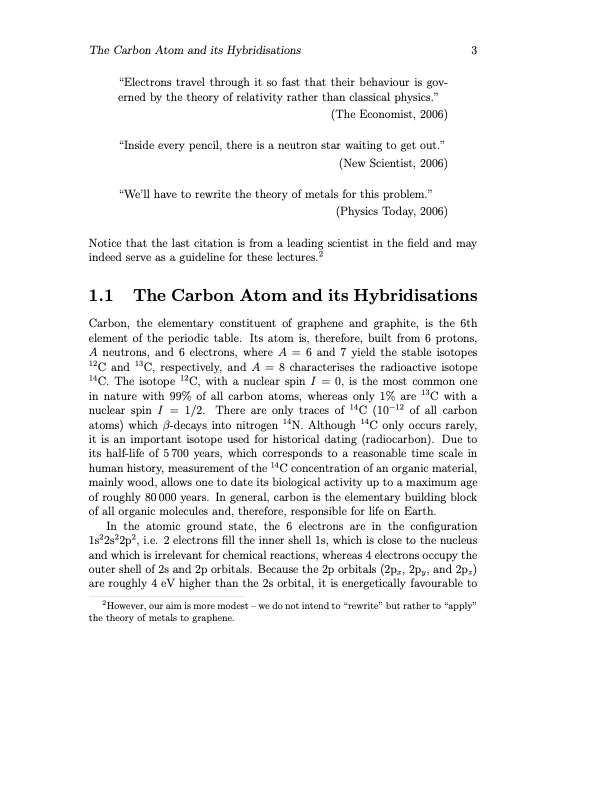PDF Publication Title:
Text from PDF Page: 007
The Carbon Atom and its Hybridisations 3 “Electrons travel through it so fast that their behaviour is gov- erned by the theory of relativity rather than classical physics.” (The Economist, 2006) “Inside every pencil, there is a neutron star waiting to get out.” (New Scientist, 2006) “We’ll have to rewrite the theory of metals for this problem.” (Physics Today, 2006) Notice that the last citation is from a leading scientist in the field and may indeed serve as a guideline for these lectures.2 1.1 The Carbon Atom and its Hybridisations Carbon, the elementary constituent of graphene and graphite, is the 6th element of the periodic table. Its atom is, therefore, built from 6 protons, A neutrons, and 6 electrons, where A = 6 and 7 yield the stable isotopes 12C and 13C, respectively, and A = 8 characterises the radioactive isotope 14C. The isotope 12C, with a nuclear spin I = 0, is the most common one in nature with 99% of all carbon atoms, whereas only 1% are 13C with a nuclear spin I = 1/2. There are only traces of 14C (10−12 of all carbon atoms) which β-decays into nitrogen 14N. Although 14C only occurs rarely, it is an important isotope used for historical dating (radiocarbon). Due to its half-life of 5700 years, which corresponds to a reasonable time scale in human history, measurement of the 14C concentration of an organic material, mainly wood, allows one to date its biological activity up to a maximum age of roughly 80 000 years. In general, carbon is the elementary building block of all organic molecules and, therefore, responsible for life on Earth. In the atomic ground state, the 6 electrons are in the configuration 1s22s22p2, i.e. 2 electrons fill the inner shell 1s, which is close to the nucleus and which is irrelevant for chemical reactions, whereas 4 electrons occupy the outer shell of 2s and 2p orbitals. Because the 2p orbitals (2px, 2py, and 2pz) are roughly 4 eV higher than the 2s orbital, it is energetically favourable to 2However, our aim is more modest – we do not intend to “rewrite” but rather to “apply” the theory of metals to graphene.PDF Image | Physical Properties of Graphene

PDF Search Title:
Physical Properties of GrapheneOriginal File Name Searched:
CoursGraphene2008.pdfDIY PDF Search: Google It | Yahoo | Bing
Salgenx Redox Flow Battery Technology: Power up your energy storage game with Salgenx Salt Water Battery. With its advanced technology, the flow battery provides reliable, scalable, and sustainable energy storage for utility-scale projects. Upgrade to a Salgenx flow battery today and take control of your energy future.
CONTACT TEL: 608-238-6001 Email: greg@infinityturbine.com (Standard Web Page)